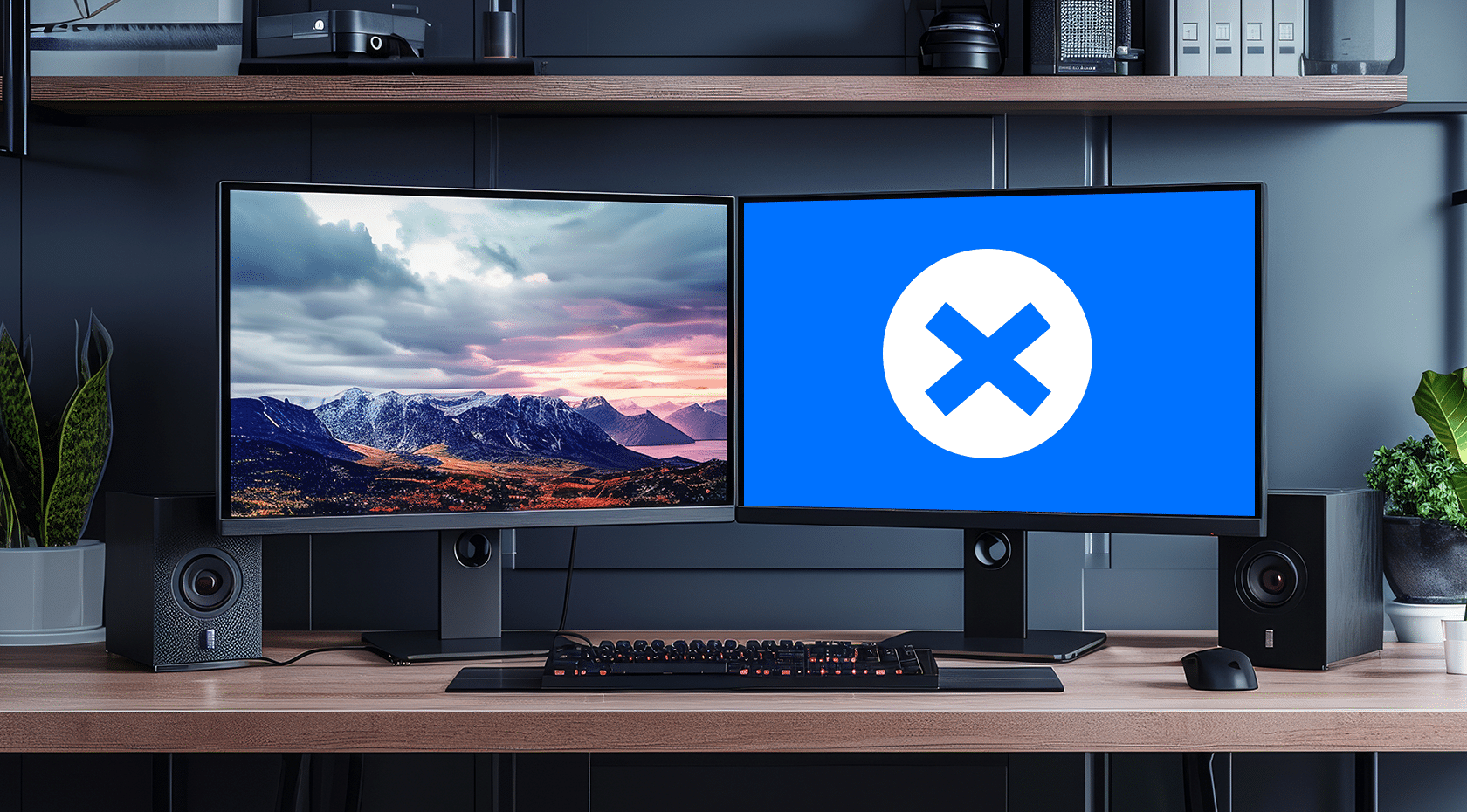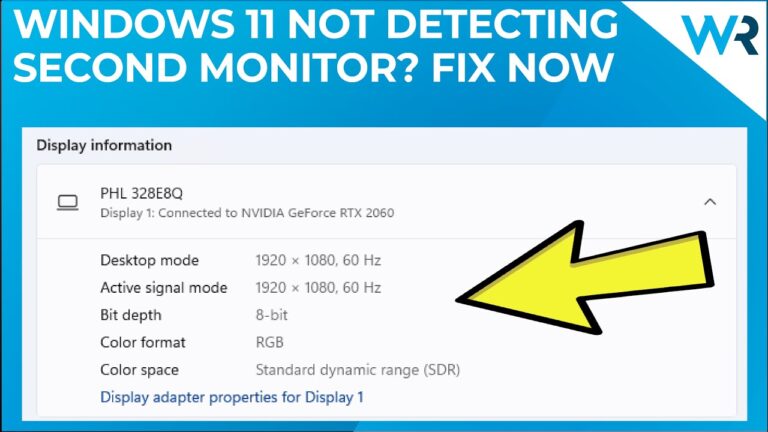Ensure both monitors are connected and powered on. Update your graphics driver to the latest version.
Experiencing issues with your second monitor not being detected on Windows 11 can be frustrating. It disrupts productivity and workflow, making it essential to resolve the problem quickly. Often, the cause is a simple hardware or software issue that can be fixed with a few troubleshooting steps.
Ensuring that both monitors are properly connected and powered on is the first step. Updating your graphics driver to the latest version can also resolve detection issues. This guide will walk you through the necessary steps to get your second monitor working seamlessly on Windows 11.

Credit: www.driversupport.com
Check Physical Connections
If your second monitor is not detected in Windows 11, first check the physical connections. Ensure all cables and ports are correctly connected.
Cable Inspection
Inspect the cables for any visible damage. Look for frays, cuts, or bent pins.
Try a different cable if you suspect the current one is faulty. Damaged cables often cause connection issues.
Use a cable that is known to work. This helps eliminate the cable as the problem.
Port Compatibility
Ensure the ports on both your computer and monitor are compatible. Check if you are using HDMI, DisplayPort, or VGA.
If the ports are different, use an appropriate adapter. Adapters can help bridge the gap between different types of ports.
Refer to the table below for common port types and their adapters:
| Port Type | Compatible Adapter |
|---|---|
| HDMI | HDMI to VGA, HDMI to DisplayPort |
| DisplayPort | DisplayPort to HDMI, DisplayPort to DVI |
| VGA | VGA to HDMI, VGA to DisplayPort |
Ensure the ports are clean and free from dust. Dust can interfere with the connection.
Try connecting the monitor to a different computer. This helps check if the monitor or port is faulty.
Update Graphics Drivers
Is your second monitor not detected on Windows 11? Updating graphics drivers can solve this issue. Outdated drivers often cause display problems. Follow these simple steps to update your drivers.
Using Device Manager
Device Manager helps you update drivers manually. Follow these steps:
- Press Windows + X and select Device Manager.
- Expand the Display Adapters section.
- Right-click on your graphics card and select Update Driver.
- Choose Search automatically for updated driver software.
- Follow the on-screen instructions to complete the update.
This method ensures you have the latest driver installed.
Automatic Driver Updates
Automatic driver updates save time and effort. Here’s how to enable them:
- Open Settings by pressing Windows + I.
- Go to Update & Security.
- Select Windows Update from the left menu.
- Click on Check for updates.
- Windows will automatically search for and install driver updates.
This method ensures your system always has the latest drivers.
Updating your graphics drivers can often resolve the second monitor detection issue on Windows 11. Use these methods to keep your system up-to-date and running smoothly.
Adjust Display Settings
If your second monitor is not detected on Windows 11, you may need to adjust the display settings. Tweaking these settings can often resolve detection issues.
Extend Display
To extend your display, follow these steps:
- Right-click on the desktop and select Display settings.
- Scroll down to the Multiple displays section.
- Choose Extend these displays from the dropdown menu.
Extending your display allows you to use both monitors as one large screen. This setup is great for multitasking.
Duplicate Display
To duplicate your display, follow these steps:
- Right-click on the desktop and select Display settings.
- Scroll down to the Multiple displays section.
- Choose Duplicate these displays from the dropdown menu.
Duplicating your display shows the same content on both monitors. This setup is useful for presentations or screen sharing.
Note: Ensure your second monitor is properly connected. Check cables and ports to avoid connectivity issues.
| Setting | Function |
|---|---|
| Extend Display | Use both monitors as one large screen. |
| Duplicate Display | Show the same content on both monitors. |
Run Hardware Troubleshooter
Experiencing issues with your second monitor not detected on Windows 11? Running the hardware troubleshooter can often solve this problem quickly. This built-in tool helps identify and fix hardware issues on your computer.
Access Troubleshooter
To access the hardware troubleshooter, follow these simple steps:
- Press Windows + I to open Settings.
- Navigate to System.
- Click on Troubleshoot in the left-hand menu.
- Under Find and fix other problems, select Hardware and Devices.
- Click on Run the troubleshooter.
Follow On-screen Instructions
Once the troubleshooter opens, it will guide you through a series of steps:
- Review the detected issues.
- Follow the on-screen prompts to resolve each issue.
- Restart your computer if necessary.
If the troubleshooter finds and fixes the problem, your second monitor should work properly.
| Step | Description |
|---|---|
| 1 | Open Settings with Windows + I. |
| 2 | Go to System and select Troubleshoot. |
| 3 | Run the Hardware and Devices troubleshooter. |
| 4 | Follow the on-screen instructions. |
Running the hardware troubleshooter can often resolve detection issues with your second monitor. It’s a quick and easy way to diagnose and fix hardware problems.
Check Monitor Power
Having trouble with your second monitor not being detected in Windows 11? The issue might be simpler than you think. Sometimes, the problem is just that your monitor isn’t getting power. Here are some steps to ensure your monitor is properly powered on.
Power Cable Check
First, ensure that the power cable is properly connected. A loose or faulty power cable can cause your monitor to not turn on. Check both ends of the cable:
- Make sure the cable is firmly plugged into the monitor.
- Ensure the other end is securely connected to the power outlet.
Try using a different power outlet. Sometimes, the outlet might be the issue. If you have a spare power cable, use it to rule out a faulty cable.
Power Button
Next, check the power button on your monitor. Ensure it is switched on. Some monitors have a small light that indicates power status:
- If the light is off, press the power button again.
- If the light is on but the screen is still dark, there might be another issue.
Sometimes, the power button might be stuck or not working properly. Press it a few times to ensure it’s functioning correctly.
If your monitor has a menu button, press it to see if the menu appears. This confirms that the monitor is receiving power.
Test With Another Device
Having trouble with your second monitor not detected in Windows 11? It might help to test with another device. This can help identify if the problem is with the monitor or the computer. Here are some steps to follow:
Using Different Pc
First, try connecting your second monitor to a different PC. This helps to see if the monitor works with another computer.
- Connect the monitor to another PC.
- Check if the monitor gets detected.
- If it works, your PC might be the issue.
If the monitor works with another PC, the problem likely lies with your original computer. Check the graphics drivers and hardware connections on your PC.
Using Another Monitor
If you have another monitor, use it to test your PC. This helps you understand if the original monitor is faulty.
- Connect a different monitor to your PC.
- Check if this monitor gets detected.
- If it works, your original monitor might be faulty.
If a different monitor works, consider troubleshooting or replacing the original monitor. This simple switch can save you from unnecessary stress.
Inspect Display Resolution
Having trouble with your second monitor not being detected in Windows 11? Inspecting the display resolution can help. Adjusting the resolution often solves detection issues. Here’s how to inspect and adjust it.
Resolution Compatibility
Ensure the resolution of both monitors is compatible. If the resolutions differ too much, Windows 11 may fail to detect the second monitor. Follow these steps:
- Right-click on the desktop and select Display settings.
- Scroll to the Resolution section.
- Select a resolution that both monitors support.
- Click Apply to save changes.
Use the table below to check common resolution compatibility:
| Resolution | Compatible Monitors |
|---|---|
| 1920×1080 | Most modern monitors |
| 2560×1440 | High-definition monitors |
| 3840×2160 | 4K monitors |
Scaling Settings
Incorrect scaling settings can cause detection issues. Adjusting scaling can help. Follow these steps:
- Open Display settings from the desktop.
- Find the Scale and layout section.
- Choose a scaling percentage that matches both monitors.
- Click Apply to save changes.
Common scaling options include:
- 100% (default)
- 125%
- 150%
Ensuring both monitors have the same scaling can resolve detection problems.
Reset Display Configuration
Sometimes, Windows 11 may not detect a second monitor. Resetting your display configuration can help. This process involves reverting your settings and reconfiguring the monitors.
Revert To Default Settings
Reverting to default settings restores your display configuration. This can fix detection issues.
Follow these steps:
- Right-click on the desktop.
- Select Display settings.
- Scroll down and click Advanced display settings.
- Choose the monitor to reset.
- Click Display adapter properties.
- Go to the Monitor tab.
- Click Properties.
- Select the Driver tab.
- Click Roll Back Driver.
Reconfigure Monitors
After reverting to default settings, reconfigure your monitors. This ensures Windows 11 detects them correctly.
Steps to reconfigure:
- Open Display settings from the desktop.
- Click Detect under the Multiple displays section.
- If not detected, click Identify.
- Drag and drop monitors to arrange them.
- Choose the primary monitor by checking Make this my main display.
This table summarizes the steps:
| Step | Action |
|---|---|
| 1 | Open Display settings |
| 2 | Click Detect |
| 3 | Click Identify |
| 4 | Arrange monitors |
| 5 | Set primary monitor |
Check For Windows Updates
Having trouble with your second monitor not being detected on Windows 11? One common fix involves checking for Windows updates. Keeping your system updated can resolve many hardware issues, including display problems.
Update Installation
First, open Settings on your Windows 11 PC. Navigate to Windows Update. Click on Check for updates. Windows will search for available updates. If updates are found, click Download and install.
| Step | Action |
|---|---|
| 1 | Open Settings |
| 2 | Navigate to Windows Update |
| 3 | Click Check for updates |
| 4 | Download and install updates |
Reboot System
After updates are installed, it’s crucial to reboot your system. This ensures all updates are applied correctly. To reboot, click the Start menu. Select Power, then click Restart.
- Open Start menu
- Select Power
- Click Restart
A reboot often resolves many issues. After rebooting, check if your second monitor is detected. If not, further troubleshooting may be needed.

Credit: www.reddit.com
Inspect System Hardware
Experiencing issues with your second monitor not being detected on Windows 11? Inspecting your system hardware is a crucial step. This inspection can help identify the root cause. Let’s dive into the key areas you should focus on.
Graphics Card Check
Your graphics card could be the culprit. Follow these steps to check it:
- Ensure the graphics card is properly seated in the slot.
- Verify that all connections are secure.
- Check if the card’s drivers are up-to-date.
- Use Device Manager to see if the card is working correctly.
Updating drivers can fix many issues. Visit the manufacturer’s website for the latest updates. If the card is faulty, consider replacing it.
Monitor Hardware Issues
Inspect the monitor itself. Sometimes, the issue lies with the hardware:
- Check the power cable and ensure it is plugged in.
- Examine the display cable for any damage.
- Try a different cable or port.
- Connect the monitor to another computer to see if it works.
If the monitor works with another device, the problem may be with your PC. If not, you might need a new monitor.
Use these steps to diagnose hardware issues. Proper inspection can save you time and frustration.

Credit: www.youtube.com
Frequently Asked Questions
Why Isn’t Windows 11 Detecting My Second Monitor?
Windows 11 may not detect your second monitor due to outdated drivers, wrong display settings, or faulty cables. Ensure all connections are secure. Update your graphics drivers. Check display settings in Windows.
Why Is My Second Monitor Not Being Recognised?
Your second monitor might not be recognized due to loose cables, outdated drivers, or incorrect display settings. Check connections, update drivers, and adjust display settings.
How Do I Get Dual Monitors To Work On Windows 11?
To get dual monitors working on Windows 11, connect both monitors to your PC. Open Settings > System > Display. Click “Detect” if needed. Adjust display settings and choose “Extend these displays. ” Save changes.
Conclusion
Troubleshooting a second monitor not detected in Windows 11 is manageable with the right steps. Follow the outlined solutions to resolve the issue efficiently. Ensure your drivers are updated and cables are secure. By doing so, you can enhance your productivity with a seamless dual-monitor setup.
Happy computing!

Hello Good People! This is Pavel and Welcome to PC Delight!
I’m an Electronics Engineer by profession with a passion for Gaming & PC builds. When I came up with the idea for PC Delight, it was my goal to share & offer the very best PC building ideas to tech-loving people like myself.
Since my school days, I’ve been just addicted to gaming & PCs. That leads me to experiment with various ways around the very niche, resulting in great productivity. And I’m here to share those practical experiences. So that next time you start some experiment with your PC builds or struggle to cope with a certain game, I’m here with the solutions. With these philosophies, I started my journey in 2017 and just kept going.
